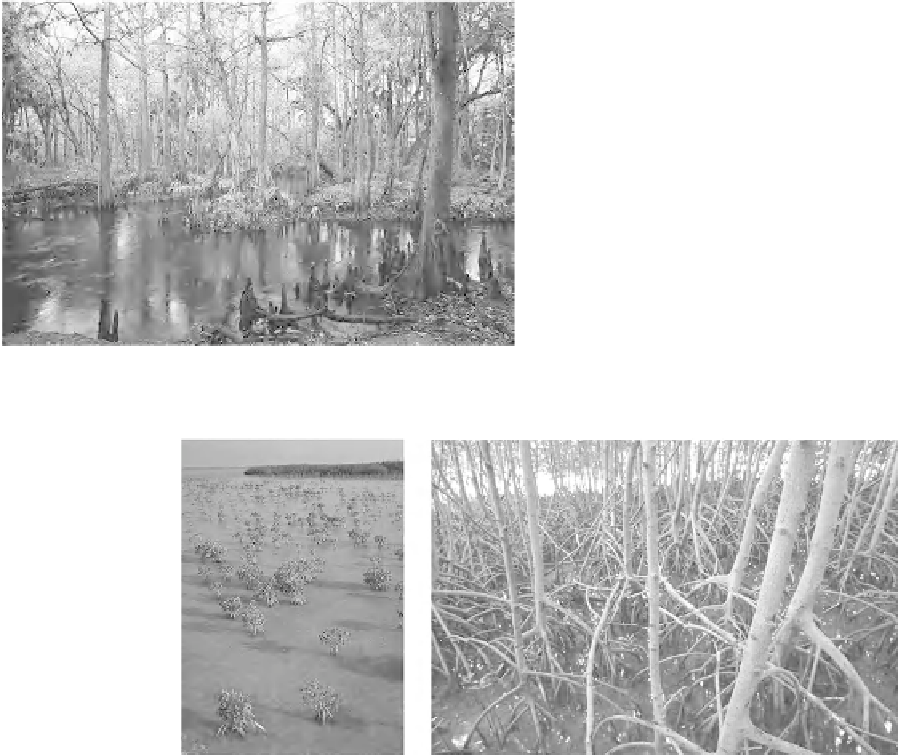Environmental Engineering Reference
In-Depth Information
Bottomland hardwood swamps
are found along rivers
and streams in the southeast and south-central United
States, generally in broad floodplains. These forested
wetlands are typically made up of different species of
gum (
Nyssa
spp.), oak (
Quercus
spp.), and bald cypress
(
Taxodium distichum
); these trees have the ability to
survive in areas that are either seasonally flooded or
covered with water much of the year. Bottomland hard-
woods swamps serve a critical role in a watershed by
reducing the risk and severity of flooding to downstream
communities by providing areas to store floodwater. In
addition, hardwood forests improve water quality by
filtering and flushing nutrients, processing organic
wastes, and attenuating sediment before it reaches open
water.
are a common type of shrub swamp dominated by man-
groves, as illustrated in Figure 8.3. Most mangrove
swamps are denser than shown in Figure 8.3a, and
Figure 8.3b shows a close-up view of a typical dense
mangrove swamp. Mangrove swamps are coastal wet-
lands found in tropical and subtropical regions. The
word
mangrove
refers to both the wetland itself and to
the salt-tolerant trees that dominate these wetlands.
Florida's southwest coast supports one of the largest
mangrove swamps in the world. In the continental
United States, only three species of mangrove are found:
red, black, and white mangroves. red mangrove (
Rhi-
zophora mangle
) is easily recognized by its distinctive
arching roots. Black mangrove (
Avicennia
spp.), which
often grows more inland, has root projections (pneu-
matophores), which help to supply the plant with air in
submerged soils. White mangroves (
Laguncularia race-
mosa
) grow farther inland with no outstanding root
structures. Mangrove swamps are constantly replen-
ished with nutrients transported by freshwater runoff
from the land and flushed by the ebb and flow of tides.
Mangroves perform a variety of important functions,
such as buffering the shoreline against heavy wave
action, filtering sediment- and pollutant-laden water,
preventing shoreline erosion, and serving as rookeries
for a variety of wading birds. Mangrove trees support a
significant fish habitat for many juvenile fish species,
including barracuda and snapper.
Shrub Swamps. Shrub swamps
are similar to forested
swamps except that shrubby vegetation, such as but-
tonbush, willow, dogwood (
Cornus
spp.), and swamp
rose (
Rosa palustris
), predominates. Mangrove swamps
8.2.1.3 Bogs.
Bogs
are one of North America's most
distinctive types of wetland. They are characterized by
spongy peat deposits, acidic waters, and a floor covered
by a thick carpet of sphagnum moss. A typical bog (the
Männikjärve bog in Estonia) is illustrated in Figure 8.4.
Bogs receive all or most of their water from precipita-
tion rather than from surface runoff, groundwater, or
streams. Consequently, bogs are low in the nutrients
Figure 8.2.
Typical forested swamp.
(a)
(b)
Figure 8.3.
Mangrove swamp: (a) isolated mangroves; (b) dense mangrove forest.

Search WWH ::

Custom Search